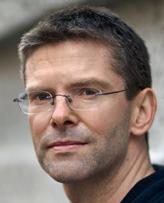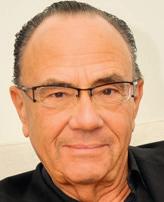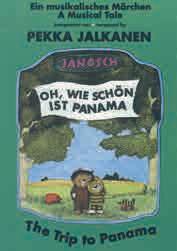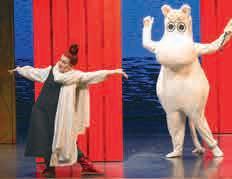DANIEL BÖRTZ

Medea (2012-14) Dur: 130’
Libretto: Daniel Börtz after Euripides (Sw/Ger)

7 sol, speaking part, women’s choir and orch: 3333-4331-05-1-str
The opera is based on the myth of Medea from Colchis, who carries out a bloody revenge after being abandoned by her husband Jason, and finally even takes the life of her two children.
The music ranges from intensive suggestion and restless strings, over vibrating emotions, marked rhythmical percussion accents and violent outbursts, to endless tranquillity in chaos. It delves deep into the human psyche, especially Medea’s, a demanding role for a dramatic soprano who is on stage the whole time. The choir of women follows Medea’s fate, they comment and react.
KIMMO HAKOLA

Akseli (2012) Dur: 70’
Libretto: Pekka Hako (Fin) baritone and chamber ensemble (8 players)
A monologue opera originally composed for Jorma Hynninen, Akseli tells of the great Finnish painter Akseli Gallén-Kallela (1865–1931) in a metaphorical portrait of his mindscapes and creative passion. The libretto traces the young artist to Paris, and from there to Berlin and light-filled Africa. Hakola’s music is at times bursting with National-Romantic melody, waltz rhythms and elements of folk and electronic music, with an intensity that never flags.
MIKKO HEINIÖ
Johanna (2016-18) Dur: 105’
Libretto: Pirkko Saisio (Fin) 7 sol, chorus and orch: 2222-2210-10-str
Due to cancelled performance plans the opera Johanna is now available for a premiere – an opportunity worth grabbing! The powerful libretto weaves together the stories of 15th-century Joan of Arc and Johanna, a 21st-century drama-queen entertainer. On the surface, it is about two provocative, charismatic women – but also their abuse and exploitation. Joan/Johanna is a dual role, one for each historical context, and the same applies for other singers. Heiniö’s music has his strong signature rhythmic and sensual charge and there are some mighty choral scenes.
FREDRIK HÖGBERG/NICOLAI DUNGER
Stilla min eld (Appease My Fire) (2016)
Dur: 120’
Libretto: Kerstin Gezelius/Alexander Onofri (Sw/Eng)
5 sol, fl-cl-pf- perc-string trio
The plot is set in a luxurious flat in central London. Hans K. Rausing, heir to the TetraPak conglomerate, locks himself in with his dead wife Eva for two months. The two had vowed eternal love to one another, not even death could separate them. A poignant and deeply tragic story about love and drug abuse, based on true events. The music is kept close to the feelings described in the text. It is very direct and melodious with a dark, melancholy tone.
FREDRIK HÖGBERG


The Woman of Cain (2009-13) Dur: 135’
Libretto: Tove Alsterdal (Eng)
8 sol, speaking part, choir, dancers and orch: 3333-4231-13-1-str
This is the story about the woman of Cain, whose origin and identity until now have remained unknown. It is a story about the people who believed they were the first people on earth; a drama about truth and lies, forbidden love, the everlasting dream of a paradise and human struggle to control life itself. With irresistible post-modern music and optional spectacular multimedia scenographics noted in the score.
OLLI KORTEKANGAS
Elämänkuvat (Pictures of Life) (2018)
Dur: 55’
Libretto: Pia Perkiö (Fin)
2 sol (soprano, baritone), chorus and orch: 2121-2110-11-cemb-str
This church opera is a recent gem: music of both bubbling joy and resignation tinged with melancholy, along with mystical allusions to the other world. The vocal parts are skilfully written, Kortekangas being thoroughly familiar with the human voice. Included is an impressive orchestral intermezzo, which according to the critics is possibly the finest music by Kortekangas
Topical operas
ever heard. The libretto lets the different time perspectives meet in an emotionally touching way with two main characters in dialogue: Maalari (a Painter) and Mariia.
JYRKI LINJAMA
Kolme kirjettä Laestadiukselle (Three Letters to Laestadius) (2015-17) Dur: 110’

Libretto: Michael Baran (Fin)

2 sol (baritone, mezzo-soprano), hn-perc-cembvl-vla-vc
This significant polemic church opera has aroused a wealth of emotions and speaks to listeners regardless of religious background. Laestadius encounters an angel, sees flashbacks from his own life and receives letters from women contemporaries abused by the religious community. It is to these women that he speaks; his questions are addressed to God. The result is an impressive drama acted out in intense and subtle music.
PASI LYYTIKÄINEN
Der unveröffentlichte Film der Eva Braun (The unpublished tape of Eva Braun) (2019-20) Dur: 35’
Libretto: Maritza Núñez (Ger) soprano and chamber ensemble (9 players)
This brand-new monologue opera is an absurd, surreal description of the aging Eva Braun tracing her life, choices, emotions, regrets and forgotten dreams. It is a highly entertaining show which also has its dramatic, more serious turns. The music does not have any dull moments: it moves forward with a drive and includes catchy stylistic allusions: folk songs, marches and jazzy schlagers in cabaret style. This is a dream role for any soprano!
JUHANI NUORVALA


Flash Flash - The Two Deaths of Andy Warhol (2005) Dur: 120’
Libretto: Juha Siltanen (Eng) 5 sol, tap dancer, 2 keyboards-perc-elgtr-vla-vcl (amplified)
A pop-inflected, seductively melodious, absurd and thrilling opera which has enjoyed almost a cult status in Finland. Included is a stunning tap dance scene and many more surprises. The libretto draws a portrait of Andy Warhol as a lonely man surrounded by the masses. Nuorvala utilises an unusual microtonal tuning system to imbue the music with a fascinating sense of the unreal.
SVEN-DAVID SANDSTRÖM


Föreställningen (The Performance) (2013) Dur: 60’
Libretto: Katarina Frostenson (Sw) 3 sol, cl-perc-pf-string quartet
Three women find themselves at the mental hospital La Salpêtriére in Paris in the late 19th century, waiting for their turn to expose their states of mind before the world-renowned Dr. Charcot and an audience of celebrities. One can sense the women´s apprehension and anxiety in the music´s rapid fluctuations between the deeply painful and the joyful lovely melodies. An ingenious feature are the deep Balinese gongs that accentuate the darkness in the story.
ALBERT SCHNELZER
Norrmalmstorgsdramat (The Stockholm Syndrome) (2017)
Dur: 110’
Libretto: Patrik Sörling (Sw) 5 sol, dancer, orch: 1111-1110-01-pf/cel-str (11111)
A psychologically gripping chamber opera about the hostage drama in central Stockholm in 1973, when an armed man walked into a bank and took four bank employees hostage. The drama gave rise to the concept ”The Stockholm Syndrome”, meaning that the victim starts to sympathise with the perpetrator. Schnelzer’s music is fateful and full of tension, with urgent rhythms of ticking woodwinds and pulsating strings. Above this, the soloist parts are strikingly attractive with their melancholy melodies. Equally so are the ensemble parts, as in the concluding chorale where the entire hostage group and the robber, resigned to their fate, sing the words ”to die at one’s post – how sweet it will be”.
HIGHLIGHTS 3/2021 6 REPERTOIRE TIPS
Chamber operas Repe R toi R e tips
K ALEVI A HO
Frida y Diego - Fresco operistico (2013)
Dur: 148’
Libretto: Maritza Núñez (Spa)
9 sol, 1121-1111-02-hp.theremin-str-mixed choir
The opera picks out dramatic twists in the lives of Frida Kahlo and Diego Rivera, and of Lev Trotsky, exiled in Mexico. Frida’s alter ego is also present. Aho’s music shines and glows in sumptuous Latino colours. The 29-piece orchestra includes such instruments as a Mexican folk harp and a theremin. The mood varies from dreamy to wildly carnivalistic, and there is also some sharp political parody.
SVEN-ERIK BÄCK
Tranfjädrarna/The Twilight Crane/ Die Kranichfedern (1957) Dur: 55’
Libretto: Bertil Malmberg after a play by Junji Kinoshita (Sw/Eng/Ger)

4 sol, 1001-1000-11-0-cel-str (00321)- mixed choir
Opera in five tableaux based on a Japanese tale about the consequences of greed. The farmer Yohio saves the life of a crane, who in gratitude returns to him in the form of a woman, Tsu. From crane feathers she weaves the most beautiful textiles, but her husband must never see her weaving. The suggestive plot is told by very simple means: the song melody lies very close to the spoken word, and the transparent orchestral texture has a Japanese touch.
DANIEL BÖRTZ
Svall /Surge (2003) Dur: 100’
Libretto: Claes Fellbom (Sw) 8 sol, 2221-2210-11-pf-str-mixed chorus á 8
Surge is a two-act tragedy based on real events, two widely publicized honor killings that took place in Sweden in the beginning of the 2000s. The vocal parts ranges from the most beautiful lyrical song to purely spoken words. The music is rich in nuances and underlines and deepens, in abrupt changes, moods and emotions. A small chorus comments on the course of events, and the baritone saxophone plays an important role as the mouthpiece of brutality.
KIMMO HAKOLA
Marsin mestarilaulajat/Die Meistersinger vom Mars (2000) Dur: 70’
Libretto: Matti Hagelberg, Karla Loppi (Fin/Ger) 4 sol, fl-cl-vl-vc or chamber orchestra & CD
This is a “comics opera”. Hakola has translated Hagelberg’s cartoons into a humoristic work which is absurd, surrealistic and one of the most delightful contemporary operas. The music wildly blends ingredients in a post-modern spirit and presents some astonishing combinations, such as minimalism and Baroque. Piia and Anu Komsi in the leading roles made the premiere in 2000 an absolute riot.
FREDRIK HÖGBERG/ NICOLAI DUNGER
Stilla min eld/Appease My Fire (2016) Dur: 120’
Libretto: Kerstin Gezelius/Alexander Onofri (Sw/ English translation is under way)
5 sol, fl-cl-pf- perc-string trio
The plot is set in a luxurios flat in central London. Hans K. Rausing, heir to the TetraPak conglomerate, locks himself in with his dead wife Eva for two months. The two had vowed eternal love to one another, not even death could separate them. A poignant and deeply tragic story about love and drug abuse, based on true events. The music is kept close to the feelings described in the text. It is very direct and melodious with a dark, melancholy tone.
OLLI KORTEKANGAS
Yhden yön juttu/One Night Stand (2011) Dur: 120’
Libretto: Michael Baran (Fin) 18 sol, 1121-2110-02-hp-pf(+synth)-el.guit-strmixed choir
This modern opera is a detective and love story hybrid. The main role is sung by either a soprano or, in the alternate cast, a tenor – hence the love is between either two women or a man and a woman. There was a new approach to processing the opera in real-time interactiveness in workshops at the Sibelius Academy.
In the skilful music classical is mixed with contemporary sound phenomena such as popular music and jazz.
TIMO-JUHANI KYLLÖNEN
Tango solo (2010) Dur: 54’
Libretto: Maritza Núñez (Spa) 1 sol, fl/acc/pf/string quartet
Tango Solo is a monologue opera, a song to love and dreams. The events are set in night-time Buenos Aires. Nicole (soprano) awaits the arrival of a comet and hovers on the borders of madness, death and life. The opera is simultaneously dreamy, sensual, passionate and realistic. Kyllönen’s music carries tango and milonga references, and the accordion gives the opera a feeling of Argentina.
JYRKI LINJAMA
Die Geburt des Täufers (2010) Dur: 85’
Libretto: Jyrki Linjama, Matti Kontio, Jussi Tapola (Ger) 4 sol, 0000-1000-01-str
This church opera is about the birth of John the Baptist and places texts from the Bible, the Gospel according to Luke and The Song of Songs in touch with the present day. Linjama works with musicalhistorical layers and uses them to construct an impressive, moving drama. The well-crafted music truly speaks to the listener, rises in places to lofty heights and culminates in The Magnificat.
VELI-MATTI PUUMALA
Anna Liisa (2006) Dur: 145’ 20 sol, 2121-2220-02-pf-str
Libretto: Puumala, Tiina Käkelä-Puumala (Fin) A powerful, timeless work with a message and hailed by the critics as a great new Finnish opera. The libretto is based on the classic play of the same name by Minna Canth and addresses the themes of the status of a young woman with a secret, and liberation in a rural community. Folkloristic music plays an important part in it and there are often some beautiful balladlike episodes.
SVEN-DAVID SANDSTRÖM
Föreställningen/The Performance (2013) Dur: 60’
Libretto: Katarina Frostenson (Sw) 3 sol, cl-perc-pf-string quartet
Three women find themselves at the mental hospital La Salpêtriére in Paris in the late 19th century, waiting for their turn to expose their states of mind before the world-renowned Dr. Charcot and an audience of celebrities. One can sense the women´s apprehension and anxiety in the music´s rapid fluctuations between the deeply painful and the joyful lovely melodies. An ingenious feature are the deep Balinese gongs that accentuate the darkness in the story.
TAPIO TUOMELA
Äidit ja tyttäret/Mothers and Daughters (1999) Dur: 100’
Libretto: Paavo Haavikko (Fin) 10 sol, 2221-2111-20-pf-str






The focus in this opera inspired by The Kalevala is on strong, archetypical women and the Don Juan-like character of Lemminkäinen. The writing for the orchestra is colourful, and the vocally-rewarding music allows room for both bel canto and more speech-like techniques. The women’s singing tradition rooted in folk music also has a place in the work, in the form of a trio of women who comment on the events.
CARL UNANDER SCHARIN





Hummelhonung/Sweetness (2001)
Dur: 135´
Libretto: Magnus Carlbring after a novel by Torgny Lindgren (Sw)
7 sol, 1111-1110-01-0-synth-str (11111)
A burlesque thriller in two acts about brotherhood, madness, hate and death. Two elderly terminally ill brothers in a remote country district hate each other with a passion. The only thing keeping them alive is the will to survive the other. The music is very well balanced, suggestive and minimalist.
KALEVI AHO
Before We All Are Drowned
1995/99, dur: 130’, sol: S, M, A, T, 2Bar, B, 2 boys, 11.asax.heckelphone. 22-2111-01-1-str
Libretto: composer (Fin/Ger)

Aho’s opera, based on a play by Juha Mannerkorpi, is a forceful drama about a nurse who succumbs to the pressures of work and her private life and commits suicide by jumping off a bridge right at the start of the opera. The events leading up this extreme act are revealed as flashbacks that say much about the hardness of our society. Aho’s music does not leave anyone cold; its great emotional content gets right inside the listener and grips its guts.
DANIEL BÖRTZ
Marie Antoinette
1997, dur: 152’, sol: 3S, 4Mz, A, 5T, 6Bar, 4B, boy, speaking part, 2232-220-11-0-str
Libretto: Claes Fellbom (Sw)

A dramatic opera about Marie Antoinette’s love affair with the Swedish count Axel von Fersen. Börtz and Fellbom use a kind of film technique in this opera, with quick changes between various periods and places. The music, too, changes rapidly between solos, dialogues, ensembles and mass scenes in a varied tone language that includes everything from dense chamber music and borrowed melodies to the convulsed volcanic musical eruption that depicts the storming of the Bastille.
MIKKO HEINIÖ
Käärmeen hetki (The Hour of the Serpent) 2002-05, dur: 140’, sol: 3S, 1Mz, A, T, Bar, BBar, B, coro, 3333-4331-13-1-pf(+cel)-str+quintetto scenico
Libretto: Juha Siltanen (Fin)
This opera is a character drama focusing on one woman and four men. In order to defend her honour, Alice holds on to a lie which leads those around her to their destruction. The work unfolds slowly, like the most sophisticated thriller, and the music proceeds through cantatas, pop songs and Khachaturian-like waltzes, while also taking in beautiful ensemble scenes that respect the old opera tradition.
FREDRIK HÖGBERG
The Woman of Cain 2009/13, dur: 135’, sol: S, Mz, 3T, Bar, 2B, speaking part, coro, dancers, 3333-4231-13-1-str
Libretto: Tove Alsterdal (Eng)
This is the story about the woman of Cain, whose origin and identity until now have remained unknown. It is a story about the people who believed they were the first people on earth; a drama about truth and lies, forbidden love, the everlasting dream of a paradise and human struggle to control life itself. With irresistible post-modern music and optional spectacular multimedia scenographics noted in the score.
OLLI KORTEKANGAS
Marian rakkaus (Maria’s Love) 1996-99, dur: 80’, sol: S, MZ, A, 3T, 2Bar, BBar, mimic, coro, 3333-4331-13-hp-cel(+pf)-str
Libretto: Paavo Rintala (Fin)
Maria’s Love is set in 20th century Europe and based on a real story about Maria and a theologian who became a martyr to his faith in the 1940s. It is also a contemporary credo about the force of unconditional love that is able to overcome despair and even death. In places, the music features some almost Wagnerian outbursts and is not lacking in romantic references.
VELIMATTI PUUMALA
Anna Liisa 2001-06, dur: 145’, sol: 5S, 3Mz, 2CA, 3T, 4Bar, 3B, coro=singers of the smaller parts, 2121-2220-02-pf-str
Libretto: composer & Tiina Käkelä-Puumala (Fin)
Based on the play by Minna Canth of 1895, Anna Liisa is the tragic, timeless story of a secret infanticide and the consequences of the crime. The marriage of a cast-iron libretto and Puumala’s skilful and
dramatic music makes this opera a powerful and hypnotic experience. The folk music that bursts out from time to time is also an important element of the opera.
EINOJUHANI RAUTAVAARA

Das Sonnenhaus (The House of the Sun)
1990, dur: 100’, sol: 3S, Mz, A, 2T, 2Bar, B, 1111-2210-02-synth-str Libretto: composer (Fin/Ger/Eng)
This story of twin sisters and their tragic fate is not without its comical side. The old immigrants refuse to accept that the world has changed and escape into the splendid memories of their youth. Rautavaara’s music brings together Russian romances, blues, a polonaise and neo-romantic harmonic textures, and the pluralistic elements co-exist in perfect harmony. The musical core of the opera lies in the lovely lyrical ensembles, especially the twins’ duets.
JÜRI REINVERE
Purge (Puhdistus)
2011, dur: 120’, sol: 3S, Mz, T, 2Bar, 2B, coro, 3333-4331-14-2-pf(cel)-tape-str
Libretto: composer (Fin+Est)
In this acclaimed story by Sofi Oksanen war and oppression drive people to extreme acts. Zara becomes a victim of sex trafficking, while Aliide has experienced a ruthless era in a nightmarish regime. The choir occupies a big role and transforms from wedding guests and forest brothers to Soviet soldiers. Reinvere’s music contrasts the sensitive and subtle with brutality; after this highly successful opera, he received a commission from the Norwegian National Opera.
CARL UNANDER SCHARIN






Lysistrata
1997-98, dur: 90’, sol: 4S, Mz, A, 2T, Bar, B, 1010-1110-04-sax-egtr-synth-str(22211)
Libretto: Magnus Carlbring (Sw)
Based on Aristophanes´ comedy about Lysistrata, who, together with the women of Athens and Sparta, initiates a sex strike and takes over the government finances in order to put an end to the Peloponnesian War. This is a witty and entertaining opera in which the music is overflowing with fleeting associations to styles and genres – everything from lofty polyphonic hymns and musical expressionism to musicals and popular music.
EDUARD TUBIN
Barbara von Tisenhusen
1968, dur: 120’, sol: S, Mz, 2T, 2Bar, 3B, mixed chorus, 3322-4331-12-0-cel-str
Libretto: Jaan Kross (Est/Sw)
The story by Aino Kallas is set in 16th century Estonia. The protagonist is a girl of noble birth who defies her social class when she flees with a scribe. As a punishment for violating the honour of her family she is condemned to death, and is drowned by her own three brothers in a hole in the ice. Tubin’s music is palpably vocal and accompanies the course of events. It begins with happy wedding music in a dancing mood, and ends with icy chords that radiate the chill of death.
LARSJOHAN WERLE
Tintomara
1973, dur: 130’, sol: 6S, Mz, A, 4T, 6Bar, 5B, speaking part, 2222-4221-11-1-pf-str
Libretto: Leif Söderström (Sw/Eng)

Based on CJL Almqvists’s novel The Queen’s Tiara, the story takes place around the time of the assassination of King Gustav III of Sweden. The beautiful, androgynous Tintomara is accused of complicity in the conspiracy. She is the object of attraction for both men and women, something which leads to jealousy, insanity and death. Werle depicts the complicated interplay with the enigmatic Tintomara by employing subtle harmonic fluctuations. We can hear both the “contemporary” Werle and romantic melodies that sound almost as if they were taken from the time of Almqvist´s “Songes”.

HIGHLIGHTS 2/2014
REPERTOIRE TIPS Operas with female focus









































